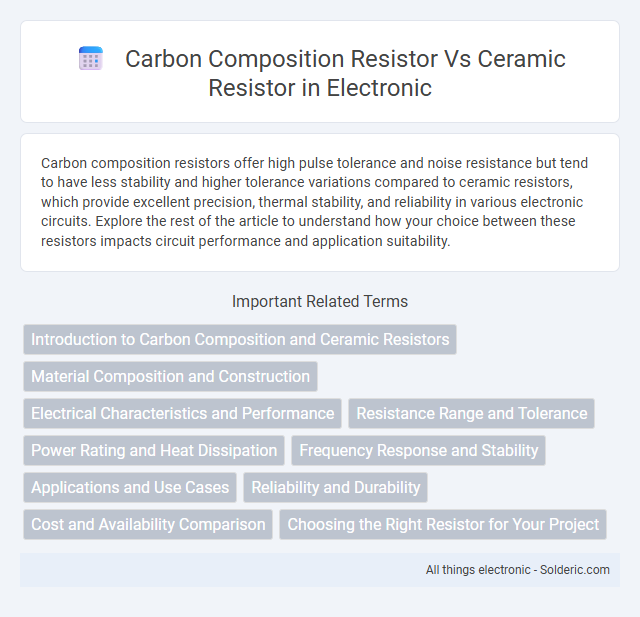Carbon composition resistors offer high pulse tolerance and noise resistance but tend to have less stability and higher tolerance variations compared to ceramic resistors, which provide excellent precision, thermal stability, and reliability in various electronic circuits. Explore the rest of the article to understand how your choice between these resistors impacts circuit performance and application suitability.
Comparison Table
| Feature | Carbon Composition Resistor | Ceramic Resistor |
|---|---|---|
| Material | Carbon powder and binder | Ceramic substrate with metal film or thick film |
| Resistance Range | 1 ohm to 22 MO | 0.1 ohm to several MO |
| Power Rating | 0.125W to 5W | 0.1W to 10W |
| Tolerance | +-5% to +-20% | +-1% to +-5% |
| Temperature Coefficient | High (less stable) | Low (more stable) |
| Noise | Higher noise level | Low noise |
| Applications | High energy pulse circuits, vintage electronics | General purpose, precision applications |
| Cost | Low | Moderate to high |
| Reliability | Lower, degrades over time | High, long lifespan |
Introduction to Carbon Composition and Ceramic Resistors
Carbon composition resistors are made from a mixture of carbon powder and a binding material, offering high energy pulse tolerance and stable resistance in high-frequency applications. Ceramic resistors consist of a ceramic core coated with resistive elements, providing excellent heat dissipation and durability under high-temperature conditions. Your choice between these resistor types should consider environmental stability and electrical performance requirements.
Material Composition and Construction
Carbon composition resistors use a mixture of carbon powder and a non-conductive ceramic binder, molded into a cylindrical shape with metal leads, providing a uniform resistive element throughout the material. Ceramic resistors consist of a ceramic substrate coated with a thin film or metal oxide layer that controls resistance, offering higher stability and heat dissipation due to the ceramic base. Understanding this difference in material composition and construction helps you choose the right resistor for applications requiring precision or high-temperature tolerance.
Electrical Characteristics and Performance
Carbon composition resistors exhibit higher noise levels and less stability under varying temperature and humidity compared to ceramic resistors, which offer superior precision and reliability. Ceramic resistors maintain consistent resistance values with lower temperature coefficients, making them ideal for high-frequency and high-power applications. The electrical performance of ceramic resistors also includes better tolerance and reduced parasitic inductance, enhancing signal integrity in sensitive circuits.
Resistance Range and Tolerance
Carbon composition resistors typically offer resistance values ranging from 1 ohm to several megohms with tolerances around +-5% to +-20%, making them less precise but suitable for high-energy pulse applications. Ceramic resistors, specifically metal oxide and thick film types, usually provide a wider resistance range from milliohms up to tens of megaohms with tighter tolerances as low as +-1%, ensuring higher accuracy and stability in electronic circuits. The choice between them depends on the required precision and environmental stability, where ceramic resistors are preferred for consistent performance and carbon composition for surge resistance.
Power Rating and Heat Dissipation
Carbon composition resistors typically have lower power ratings, often around 0.25 to 2 watts, and exhibit poorer heat dissipation due to their construction, causing them to heat up faster under load. Ceramic resistors, such as metal oxide film or wirewound types, generally support higher power ratings up to 5 watts or more and benefit from superior heat dissipation properties because of their ceramic substrate. Choosing the right resistor for your circuit depends on managing power and thermal performance to ensure longevity and stability.
Frequency Response and Stability
Carbon composition resistors exhibit a less stable frequency response due to their inherent inductance and capacitance, causing signal distortion at higher frequencies. Ceramic resistors maintain better stability and low parasitic effects, providing a more consistent frequency response in high-frequency applications. Your choice should favor ceramic resistors for precision circuits requiring minimal signal interference and improved long-term stability.
Applications and Use Cases
Carbon composition resistors are ideal for high-energy pulse applications such as surge protectors and vintage audio equipment due to their ability to withstand large energy spikes. Ceramic resistors, known for their excellent temperature stability and high power ratings, are commonly used in power supplies, motor controls, and RF circuits. Your choice depends on the specific performance requirements, with carbon composition favored for transient loads and ceramic resistors suited for steady-state or high-power environments.
Reliability and Durability
Carbon composition resistors exhibit lower reliability and durability due to their susceptibility to moisture, temperature variations, and aging, which can cause resistance drift and failure. Ceramic resistors, on the other hand, offer superior stability and longevity, with excellent heat resistance and minimal resistance change over time, making them ideal for high-reliability applications. Choosing ceramic resistors enhances Your circuit's performance by ensuring consistent operation and extended lifespan even in harsh environments.
Cost and Availability Comparison
Carbon composition resistors generally offer lower manufacturing costs due to simpler materials and processes, making them affordable for basic electronic applications. Ceramic resistors, while slightly more expensive, provide enhanced reliability and stability, often justifying their higher price in precision circuits. Your choice depends on budget constraints and the specific performance needs of the electronic device.
Choosing the Right Resistor for Your Project
Selecting the right resistor for your project depends on factors such as tolerance, power rating, and temperature stability. Carbon composition resistors offer high energy pulse tolerance and noise generation, making them suitable for vintage audio equipment, while ceramic resistors provide better precision, thermal performance, and durability for modern electronic circuits. Evaluating the application's voltage, environmental conditions, and required reliability guides the choice between carbon composition and ceramic resistors to ensure optimal functionality and longevity.
Carbon composition resistor vs ceramic resistor Infographic

 solderic.com
solderic.com